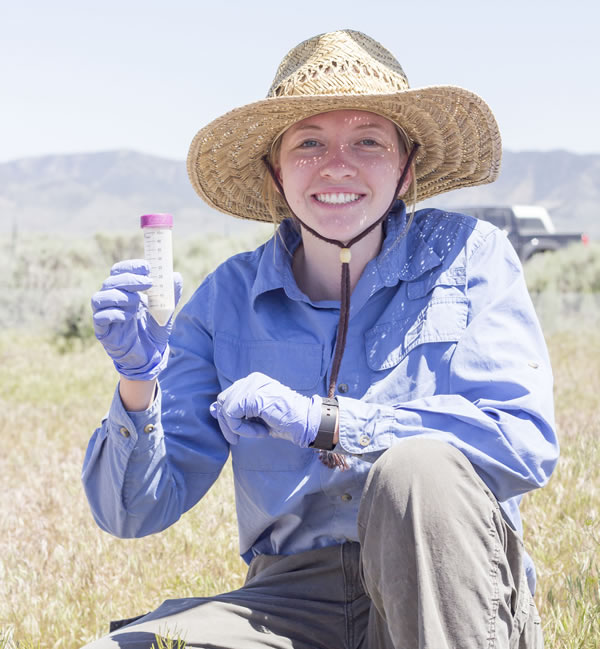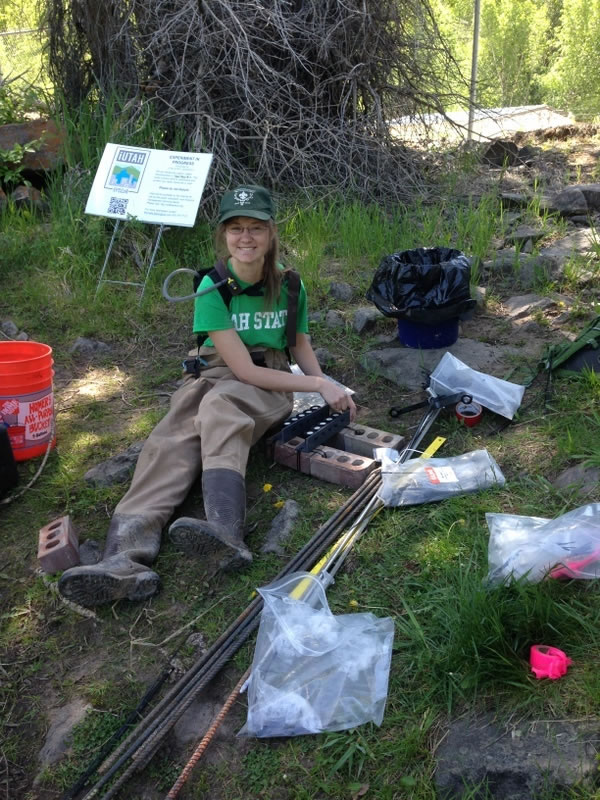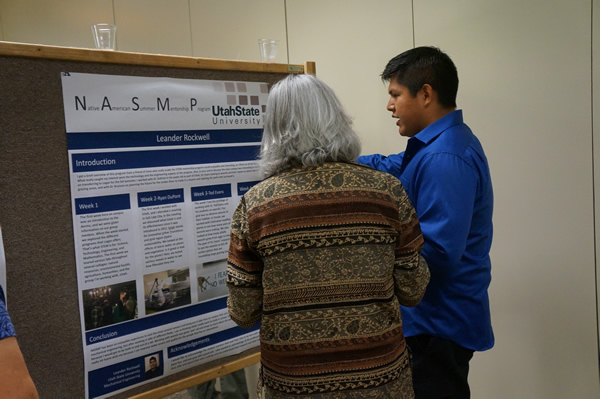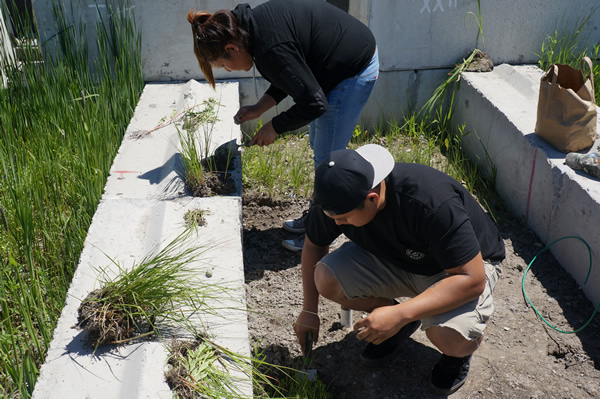News and Highlights
This is a list of past iUTAH EPSCoR news from 2012 to 2018.
June 14, 2016
18 Undergraduates Receive Support to Conduct Research This Summer
iUTAH is working hard to address Utah’s need to help students grow their interest in STEM research fields. Through its iFellows program, undergraduate students are involved in cutting-edge research and scholarly work on water-related issues. This program, now in its fourth year, takes place over an 11-week period each summer, beginning in May. Since 2013, the program has funded 63 iFellows undergraduate researchers, bringing students from around the state to Utah’s premier research institutions: the University of Utah, Utah State University, and Brigham Young University.
One of the best parts of the iFellows program is that it stimulates interest among talented undergraduates in research science careers by introducing them to the work researchers are doing. Students are involved in a wide range of research topics, ranging from aquatic biology to urban planning to environmental engineering. A key component of the program is identifying and matching student interests to research projects and mentors. Once they are assigned to a faculty member, graduate and peer mentor, students become involved in current iUTAH research projects.
This year’s 18 iFellows represent iUTAH’s continuing commitment to STEM education and diversity with 71% female and 18% under-represented minority students participating. The 2016 iFellow undergraduate researchers are listed as follows, including hometown, current institution, and iUTAH faculty mentor:
- Joydino Beyale - Red Mesa, UT, USU Eastern – Blanding, with Ryan Dupont, USU
- Heather Bottelberghe - Grantsville, UT, Salt Lake Community College, with Sarah Null, USU
- Katelyn Boyer – Springville, UT, Utah State University, with Sam St. Clair, BYU
- Todd Brown – Hooper, UT, Utah State University, with David Rosenberg, USU
- Darcie Christensen – Tremonton, UT, Utah State University, with Christine Pomeroy, UU
- Georgie Corkery – Salt Lake City, UT, University of Utah, with Steve Burian, UU
- Cynthia Elliott – Valencia, CA, Weber State University, with Mark Brunson, USU
- Andrew Hackett – Layton, UT, Weber State University, with Sarah Null, USU
- Greta Hamilton – Salt Lake City, UT, Salt Lake Community College, with Greg Carling, BYU
- Stacy Henderson – Salt Lake City, UT, Westminster College, with Joanna Endter-Wada, USU
- Rebecca Lee – San Diego, CA, Brigham Young University, with Zach Aanderud, BYU
- Gabriela Martinez – Salt Lake City, UT, Salt Lake Community College, with Sarah Hinners, UU
- Mitchell Steele – Orem, UT, Utah State University, with Ryan Dupont, USU
- Shanae Tate – Salt Lake City, UT, Brigham Young University, with Scott Jones, USU
- Luis Vidal – Logan, UT, University of Utah, with Mark Brunson, USU
- Lily Wetterlin – Midway, UT, University of Utah, with Diane Pataki, UU
- Adam Whalen – Draper, UT, University of Utah, with Sara Yeo, UU
- Sandra Udy (Young) – Vernal, UT, Utah State University, with Michelle Baker, USU
“This summer’s iFellows Program is off to a great start,” says Ellen Eiriksson, iUTAH Education, Outreach and Diversity Coordinator. “Students have arrived eager to contribute to iUTAH's multi-disciplinary research and to gain valuable experience working with the project's many inspirational faculty and near-peer mentors.” These students come from disciplines ranging from general studies and communications to environmental science and engineering. All are bringing new ideas and insights together to help address Utah’s future water concerns.


June 14, 2016
The iUTAH EPSCoR project aims to build collaboration in the form of research, training, and outreach on water sustainability for our state. As we grow, we continue to have a positive impact statewide, and beyond. We measure these successes in the people, papers, presentations, partnerships, proposals, and infrastructures we foster. Here’s a sampling of what we have done from 2012-2016.
- $19 million funding from 64 research proposals
- 170,000+people reached in 290 public outreach events
- 439 scholarly presentations and posters
- 157 publications (submitted, in press, or published)
In addition to summarizing our successes, the iUTAH website now includes a comprehensive and growing list of peer-reviewed publications written or co-authored by program participants.
More information...

June 13, 2016
USU's Native American STEM Mentorship Program Holds Poster Session
Students from Utah State University Eastern’s Blanding campus presented posters showing what they learned during this summer’s Native American STEM Mentorship program held on USU’s Logan campus. Two students, Leander Rockwell and Anna Sagg, were among the 23 undergraduate researchers. Leander and Anna worked with on iUTAH research in Ryan Dupont’s and Mark Brunson’s labs, alongside graduate, undergraduate, and iFellow peer mentors.
“This is the second year we’ve been involved with the program, and I can’t be more pleased with how it’s gone,” said Mark Brunson, iUTAH Education, Outreach and Diversity director. “Engaging with the Native American Student Mentorship Program is a perfect fit with our iUTAH goals of enhancing the diversity of participants in our state’s STEM workforce and to offer research experiences to students at colleges and universities that primarily serve undergraduates."
The poster session, held on June 6, featured studies ranging from electrochemical water splitting to thermochronology of Utah’s Wasatch Fault together with iUTAH projects involving the effects of vegetation on stormwater and surveys on water perceptions in the state.
"This was a great event, and it was great to see it so well attended, said Andreas Leidolf, iUTAH Assistant Director and Project Administrator. “I was impressed with how excited these students were to present their experiences of participating in this program to the campus community. Hearing first-hand what a difference a faculty or graduate student mentor has made in these students' lives in such a short span of time is really quite awe-inspiring, and a testament to the supportive and inclusive environment Utah State University has created."
Now in its second year, the NASM program, started with grant funding from the national Native American-Serving Nontribal Institutions initiative, encourages to students to explore advanced STEM educational opportunities and careers.


June 1, 2016
Study: Snowpack Shifts as Wasatch Warms
University of Utah and iUTAH researcher Court Strong was recently featured in the news. A new study by Strong and his colleagues finds that the spring snowpack may be more vulnerable to a warming climate in coming decades.
A news release written by the University of Utah said “The study, accepted for publication in Geophysical Research Letters, models the year-to-year variability in precipitation and temperature in Utah’s Wasatch Mountains and other ranges in the West. Jason Scalzitti, a graduate student in atmospheric sciences, and professors Court Strong and Adam Kochanski found that above a threshold elevation, the amount of spring snowpack is dependent more on the amount of precipitation in a year than the temperature. In other words, whether a year is wet matters more than if it’s warm. But below that threshold, temperature matters more. By the end of the century, according to the study, that threshold will move uphill by around 800 feet in the Wasatch and more in the Sierra Nevada, Cascades and parts of the Rocky Mountains."
In an excerpt from the KUER Radio article, "Strong and his team at the University of Utah suggest a different question: 'How warm will it be?’ That’s because of climate change. 'In the current climate, the springtime snowpack depends mainly on the precipitation we had in a particular winter and how warm it was in that winter plays a secondary role,' he says. 'But as we go out to the end of the current century, those two drivers switch places.’"
Press: UU News | EurekaAlert | KUER Radio | Inside Climate News


May 25, 2016
iUTAH partner Utah Water Watch (UWW), a Utah State University Water Quality Extension program, was featured recently by KVNU radio, out of Logan Utah. Eli Robinson, an AmeriCorps Volunteer, spoke with reporters about local water education programs. Here’s an excerpt from the interview:
Robinson said "We've been busy starting early this spring. We've traveled around to a lot of water fairs for 4th graders throughout the state. Just last week we were doing a water fair in Cache County...we were teaching kids about the watershed and how what they do on land affects the watershed."
UWW is a water quality education and data collection program that seeks to increase awareness about the importance of water quality and promote stewardship of Utah’s aquatic resources. Staff from UWW serve on the iUTAH External Engagement and Outreach team. UWW was the recipient of an iUTAH Education, Outreach, and Diversity Innovation Award in 2014.

May 25, 2016

Andreas Leidolf
During its May meeting, the National Science Foundation (NSF) Established Program to Stimulate Competitive Research (EPSCoR) Administrators (PA) Leadership Committee elected Andreas Leidolf, iUTAH Assistant Director and Project Administrator, as chair-elect. He will serve a three year appointment, moving to chair and chair emeritus, ending in May 2019. Prior to this election, Andreas served the EPSCoR PA Community as a Leadership Committee member-at-large from 2015-2016.


